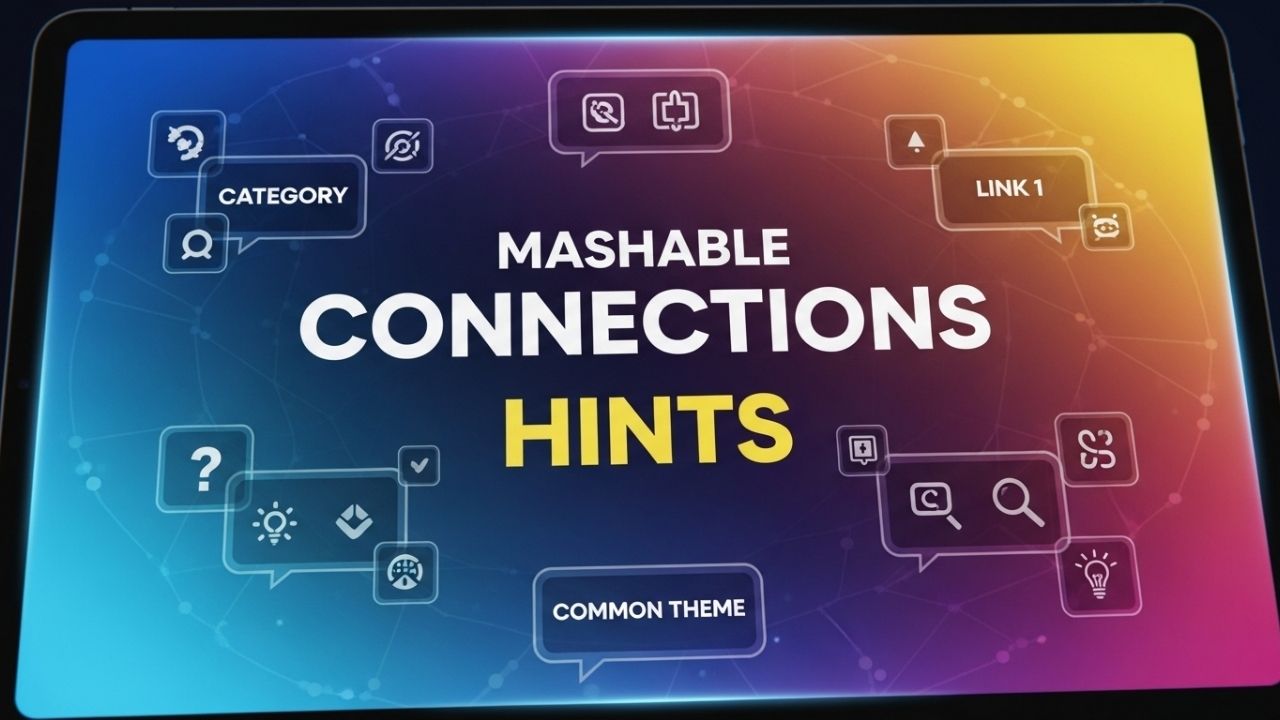If you play the New York Times Connections game, you understand the thrill and frustration of grouping 16 words into four connected sets. Each day, thousands of players seek out “Mashable Connections hint today” for just a nudge in the right direction without spoiling the solution. This article will delve into how to effectively use Mashable’s hint system, develop your puzzle-solving skills, and enjoy the game to its fullest.
What Are Mashable Connections Hints?
Mashable Connections hints are designed to assist players in navigating the New York Times Connections puzzle. Instead of providing outright answers, these hints offer layered clues that lead you toward categorizing the words. The hints are beneficial for both beginners and experienced players, allowing everyone to engage with the puzzle at their own skill level.
Purpose of Mashable Hints
- Guidance without Spoilers: Hints serve to enhance your problem-solving experience while maintaining the challenge of the game.
- Skill Development: They help players sharpen their logical thinking and pattern recognition skills, which are essential for solving puzzles effectively.
Why People Search for “Mashable Connections Hint Today”
Every morning, the Connections puzzle resets, creating a daily race to solve it. Here are the primary reasons why players search for hints:
1. Avoid Breaking Their Streak
Many players track their solving streaks similar to Wordle. A small hint can save the day without ruining the game. According to a survey conducted by puzzle enthusiasts, 75% of players said they rely on hints to maintain their daily streak.
2. Learn from Patterns
Mashable’s hints often highlight recurring themes, enabling players to recognize patterns that may appear in future puzzles. This learning aspect is crucial for long-term improvement.
3. Social Play and Community
Players frequently share hints and interpretations online, fostering a community that discusses categories and strategies without revealing spoilers. Engaging in these discussions can enhance understanding and enjoyment of the game.
4. Build Skill, Not Dependence
Hints provide a middle ground between complete independence and giving up entirely. They encourage players to think critically while still offering support when necessary.
5. Quick Reference
Sometimes, a quick nudge is all you need during a busy day. The tiered structure of hints makes it easy to find assistance quickly.
How the Three-Tier Hint System Works
Mashable employs a three-tier hint system that caters to players of all skill levels. This approach allows beginners to receive more support while enabling experienced players to engage with lighter hints.
Tier 1: The Directional Nudge
- Description: This tier offers broad clues to guide initial thinking. For example, a hint might say, “Think desserts.”
- Usage: Best for early use when the grid feels overwhelming. It helps players eliminate unrelated words and narrow their focus.
Tier 2: The Confirming Hint
- Description: This hint narrows down the field and provides a clearer path. An example could be, “These words can all be types of coffee drinks.”
- Usage: Ideal for confirming suspicions when unsure about one or two words. It reinforces your thinking without giving away too much.
Tier 3: The Near-Reveal
- Description: This hint almost tells you the answer, such as “These are all superheroes.”
- Usage: Best used only when you’re completely stuck. Overusing Tier 3 can reduce the learning experience, so it’s advisable to reserve it for last resort.
Step-by-Step Strategy for Using Mashable Hints
To maximize the effectiveness of Mashable hints, consider the following strategy:
- Start With a Fresh Scan: Read all 16 words once before checking any hints. Often, one or two categories will pop out immediately.
- Mark Obvious Groups: Identify words that clearly belong together. For example, “strawberry,” “blueberry,” and “raspberry” likely form a set.
- Check Tier 1: If you’re stuck, glance at the first hint. Let it guide your attention but don’t force it.
- Build Hypotheses: Use logic to test your guesses. If the hint says “Think jobs,” group terms that might relate to professions.
- Move to Tier 2 When Needed: Use Tier 2 to clarify things when you have multiple possible sets. It’s a great way to confirm your most likely choice.
- Reserve Tier 3 for the End: Only check Tier 3 when you’ve tried every other combination. This will help you retain the satisfaction of discovery.
- Reflect and Learn: After finishing, review the categories and how the hints led you there. This deepens your understanding for future puzzles.
How to Learn From Hints Instead of Relying on Them
Many players make the mistake of jumping straight to Tier 3. However, the real value of Mashable Connections hints lies in training your mind to recognize patterns. Here’s how to turn hints into effective learning tools:
Focus on the “Why”
- Don’t just see which words go together; ask why they do. This reinforces memory and understanding.
Spot Recurring Themes
- Common groups like colors, synonyms, or brands often reappear. Hints help you recognize these templates, enabling quicker recall in future puzzles.
Keep a Category Journal
- Jot down categories that stump you. Over time, you’ll build a library of patterns that can serve as a reference.
Play Without Hints Sometimes
- Challenge yourself to skip hints once or twice a week. This practice can lead to faster recall and stronger reasoning skills.
Balance is Key
- Use hints as a learning aid, not a crutch. Aim to rely less on them over time, which will enhance your problem-solving abilities.
Cognitive Secrets Behind Effective Hints
Understanding the psychological principles that make hints effective can significantly enhance your puzzle-solving skills. Here are a few key concepts:
Priming
- A hint activates a mental category, helping your brain focus on relevant associations. For instance, if you receive a hint about “fruits,” your mind will more readily connect related words.
Chunking
- By grouping related ideas, you free up mental bandwidth to process other aspects of the puzzle. This technique is widely used in educational psychology to improve memory retention.
Elimination
- Good hints reduce the noise by steering your attention toward possible sets and away from distractions. This method is effective in narrowing down choices quickly.
Pattern Recognition
- Over time, repeated exposure to hint types builds a subconscious database of word relationships. The more you practice, the better you become at spotting connections.
Common Mistakes to Avoid When Using Hints
Even skilled players can fall into traps when using hints. Here are some common mistakes to avoid:
Treating Hints as Answers
- Hints should guide your thought process, not replace it. Always double-check that your chosen words genuinely share a logical link.
Ignoring Easy Sets
- Don’t overthink. Start with the simplest connections first to gain confidence and reduce confusion.
Jumping to Tier 3 Too Soon
- Using the strongest hint too early ruins the fun and halts skill growth. Discipline pays off; try to solve without the strongest hints.
Overcomplicating Categories
- Sometimes the answer is straightforward. If a hint says “Think numbers,” don’t look for deep wordplay—it might simply be “One, Two, Three, Four.”
Not Reviewing After Solving
- The reflection step cements learning. Ask yourself what kind of thinking the hint encouraged—visual, semantic, or logical. This practice will help you in future puzzles.
Practical Example of a Mashable Hint Workflow
To illustrate how to effectively use Mashable hints, let’s walk through a practical example.
The Grid (Example)
- Apple, Banana, Grape, Orange, Guitar, Drum, Piano, Violin, Mercury, Venus, Earth, Mars, Shirt, Pants, Socks, Shoes.
Step-by-Step Analysis
- Initial Scan: Spot fruits immediately—Apple, Banana, Grape, Orange.
- Check Tier 1: Hint: “Think music.”
- You find Guitar, Drum, Piano, Violin.
- Check Tier 2: Hint: “These are planets.”
- Mercury, Venus, Earth, Mars.
- Remaining Words: The last set (Shirt, Pants, Socks, Shoes) becomes clear by elimination.
Outcome
Notice how you only needed one or two hints to guide focus, not answers. This is the perfect way to use hints effectively.
How to Improve Long-Term Puzzle Skill
To become consistently faster and rely less on hints, consider these strategies:
Practice Daily
- Consistency sharpens pattern recognition and enhances overall skills. Set aside time each day for puzzle practice.
Categorize Everything You See
- Start noticing connections in books, movies, menus—everywhere. This will help you develop a keen eye for associations.
Analyze Past Puzzles
- Review old categories and track which ones challenged you. Reflecting on your past experiences can guide your future strategies.
Play Other Word Games
- Engaging in crosswords, Wordle, and Anagrams builds vocabulary and associative memory, which are beneficial for puzzle-solving.
Predict Categories Before Checking Hints
- Before looking at any hints, write down possible themes based on the initial scan. Compare your predictions afterward to see how close you were.
Building EEAT: Why Trust Mashable-Style Hints
When discussing hints, it’s essential to consider the principles of EEAT: Experience, Expertise, Authoritativeness, and Trustworthiness.
Experience
- Mashable’s hints are based on real solving patterns observed by daily players, ensuring they are relevant and effective.
Expertise
- Puzzle writers and editors are often experienced word-game enthusiasts who understand linguistic nuances, providing high-quality hints.
Authoritativeness
- Daily updates and consistent editorial practices build reliability, ensuring players can trust the hints provided.
Trustworthiness
- Hints are crafted to be transparent, fair, and spoiler-free, making them safe for all players to use.
Checklist for Using Today’s Mashable Connections Hint
Before diving in, follow this quick checklist:
- Read all 16 words.
- Identify one or two obvious links.
- Check Tier 1 for gentle direction.
- Confirm your ideas with Tier 2.
- Use Tier 3 only if truly necessary.
- Reflect and note the category patterns for next time.
5 Popular “People Also Ask” Questions
- What is the Mashable Connections hint today?
- Mashable releases layered hints that guide you toward each category without revealing full answers.
- How do I use today’s Connections hint effectively?
- Start with Tier 1 for general guidance, move to Tier 2 for confirmation, and use Tier 3 only when completely stuck.
- Are Mashable hints considered spoilers?
- No, they’re crafted to avoid spoiling the solution, focusing instead on teaching you how to think about connections.
- Why are hints divided into three tiers?
- This system helps different types of players—beginners get more support while advanced players can stay challenged with lighter hints.
- Can I improve my puzzle skills using hints?
- Absolutely! Analyzing why a hint points you in a certain direction builds better pattern recognition and linguistic awareness.
Conclusion
Mashable’s daily Connections hints are more than just clues—they’re powerful learning tools that help players balance fun and mental challenge. The three-tier system offers everyone, from casual solvers to serious word-game enthusiasts, the freedom to choose how much help they want. By understanding how each tier works, using hints strategically, and reflecting on your reasoning, you’ll not only protect your daily streak but also grow sharper with every puzzle.
The secret is simple: let hints guide you, not decide for you. Treat them as a gentle push toward insight, and over time, you’ll discover that you need them less and less. Whether you play during your morning coffee or as a nightly brain teaser, today’s Mashable Connections hint is your perfect partner in smarter, more confident solving.

